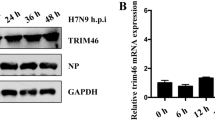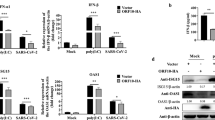Abstract
Background
Host factors are required for Influenza virus infection and have great potential to become antiviral target.
Objective
Here we demonstrate the role of TNK2 in influenza virus infection. CRISPR/Cas9 induced TNK2 deletion in A549 cells.
Methods
CRISPR/Cas9-mediated deletion of TNK2. Western blotting and qPCR was used to measure the expression of TNK2 and other proteins.
Results
CRISPR/Cas9-mediated deletion of TNK2 decreased the replication of influenza virus and significantly inhibited the ex-pression of viral proteins and TNK2 inhibitors (XMD8-87 and AIM-100) reduced the expression of influenza M2, while over-expression of TNK2 weakened the resistance of TNK2-knockout cells to influenza virus infection. Furthermore, a decrease of nuclear import of IAV in the infected TNK2 mutant cells was observed in 3 h post-infection. Interestingly, TNK2 deletion enhanced the colocalization of LC3 with autophagic receptor p62 and led to the attenuation of influenza virus-caused accumulation of autophagosomes in TNK2 mutant cells. Further, confocal microscopy visualization result showed that influenza viral matrix 2 (M2) was colocalized with Lamp1 in the infected TNK2 mutant cells in early infection, while almost no colocalization between M2 and Lamp1 was observed in IAV-infected wild-type cells. Moreover, TNK2 depletion also affected the trafficking of early endosome and the movement of influenza viral NP and M2.
Conclusion
Our results identified TNK2 as a critical host factor for influenza viral M2 protein trafficking, suggesting that TNK2 will be an attractive target for the development of antivirals therapeutics.





Similar content being viewed by others
Data availability
All data generated or analyzed during this study are included in this published article.
References
Beale R, Wise H, Stuart A, Ravenhill BJ, Digard P, Randow F (2014) A LC3-interacting motif in the influenza A virus M2 protein is required to subvert autophagy and maintain virion stability. Cell Host Microbe 15(2):239–247
Brandenburg B, Lee LY, Lakadamyali M, Rust MJ, Zhuang X, Hogle JM (2007) Imaging poliovirus entry in live cells. PLoS Biol 5(7):e183
Chan W, Tian R, Lee YF, Sit ST, Lim L, Manser E (2009) Down-regulation of active ACK1 is mediated by association with the E3 ubiquitin ligase Nedd4-2. J Biol Chem 284(12):8185–8194
Edinger TO, Pohl MO, Stertz S (2014) Entry of influenza A virus: host factors and antiviral targets. J Gen Virol 95(Pt 2):263–277
Eierhoff T, Hrincius ER, Rescher U, Ludwig S, Ehrhardt C (2010) The epidermal growth factor receptor (EGFR) promotes uptake of influenza A viruses (IAV) into host cells. PLoS Pathog 6(9):e1001099
Fedeli C, Moreno H, Kunz S (2020) The Role of receptor tyrosine kinases in lassa virus cell entry. Viruses 12(8):857
Fujimoto Y, Ochi H, Maekawa T, Abe H, Hayes CN, Kumada H, Nakamura Y, Chayama K (2011) A single nucleotide polymorphism in activated Cdc42 associated tyrosine kinase 1 influences the interferon therapy in hepatitis C patients. J Hepatol 54(4):629–639
Galisteo ML, Yang Y, Ureña J, Schlessinger J (2006) Activation of the nonreceptor protein tyrosine kinase Ack by multiple extracellular stimuli. Proc Natl Acad Sci USA 103(26):9796–9801
Gannagé M, Dormann D, Albrecht R, Dengjel J, Torossi T, Rämer PC, Lee M, Strowig T, Arrey F, Conenello G (2009) Matrix protein 2 of influenza A virus blocks autophagosome fusion with lysosomes. Cell Host Microbe 6(4):367–380
Han J, Perez JT, Chen C, Li Y, Benitez A, Kandasamy M, Lee Y, Andrade J, tenOever B, Manicassamy B (2018) Genome-wide CRISPR/Cas9 screen identifies host factors essential for influenza virus replication. Cell Rep 23(2):596–607
Hao L, Sakurai A, Watanabe T, Sorensen E, Nidom CA, Newton MA, Ahlquist P, Kawaoka Y (2008) Drosophila RNAi screen iden-tifies host genes important for influenza virus replication. Nature 454(7206):890–893
Heaton BE, Kennedy EM, Dumm RE, Harding AT, Sacco MT, Sachs D, Heaton NS (2017) A CRISPR activation screen identifies a pan-avian influenza virus inhibitory host factor. Cell Rep 20(7):1503–1512
Ison MG (2011) Antivirals and resistance: influenza virus. Curr Opin Virol 1(6):563–573
Jiang H, Chen K, Sandoval LE, Leung C, Wang D (2017) An evolutionarily conserved pathway essential for orsay virus infection of caenorhabditis elegans. MBio 8(5):e00940-17 (pii)
Jiang H, Leung C, Tahan S, Wang D (2019) Entry by multiple picornaviruses is dependent on a pathway that includes TNK2, WASL, and NCK1. Elife 8:e50276
Johannsdottir HK, Mancini R, Kartenbeck J, Amato L, Helenius A (2009) Host cell factors and functions involved in vesicular stomatitis virus entry. J Virol 83(1):440–53
Jones S1, Cunningham DL, Rappoport JZ, Heath JK (2014) The non-receptor tyrosine kinase Ack1 regulates the fate of activated EGFR by inducing trafficking to the p62/NBR1 pre-autophagosome. J Cell Sci 127(Pt 5):994–1006
Karlas A, Machuy N, Shin Y, Pleissner KP, Artarini A, Heuer D, Becker D, Khalil H, Ogilvie LA, Hess S (2010) Genome-wide RNAi screen identifies human host factors crucial for influenza virus replication. Nature 463:818–822
König R, Stertz S, Zhou Y, Inoue A, Hoffmann HH, Bhattacharyya S, Alamares JG, Tscherne DM, Ortigoza MB, Liang Y et al (2010) Human host factors required for influenza virus replication. Nature 463(7282):813–817
Kumar N, Liang Y, Parslow TG, Liang Y (2011) Receptor tyrosine kinase inhibitors block multiple steps of influenza a virus replication. J Virol 85(6):2818–2827
Lakadamyali M, Rust MJ, Zhuang X (2004) Endocytosis of influenza viruses. Microbes Infect 6(10):929–936
Lee SM, Yen HL (2012) Targeting the host or the virus: current and novel concepts for antiviral approaches against influenza virus infection. Antiviral Res 96(3):391–404
Luo M (2012) Influenza virus entry. Adv Exp Med Biol 726:201–221
Lupberger J, Zeisel MB, Xiao F, Thumann C, Fofana I, Zona L, Davis C, Mee CJ, Turek M, Gorke S et al (2011) EGFR and EphA2 are host factors for hepatitis C virus entry and possible targets for antiviral therapy. Nat Med 17(5):589–595
Mahajan K, Mahajan NP1 (2015) ACK1/TNK2 tyrosine kinase: molecular signaling and evolving role in cancers. Oncogene 34(32):4162–7
Matrosovich M, Matrosovich T, Garten W, Klenk HD (2006) New low-viscosity overlay medium for viral plaque assays. Virol J 3:63
Miaczynska M (2013) Effects of membrane trafficking on signaling by receptor tyrosine kinases. Cold Spring Harb Perspect Biol 5(11):a009035
Pinto LH, Lamb RA (2006) The M2 proton channels of influenza A and B viruses. J Biol Chem 281(14):8997–9000
Prieto-Echagüe V, Gucwa A, Brown DA, Miller WT (2010) Regulation of Ack1 localization and activity by the amino-terminal SAM domain. BMC Biochem 11:42
Ramakrishnan MA (2016) Determination of 50% endpoint titer using a simple formula. World J Virol 5(2):85–86
Reinecke J, Caplan S (2014) Endocytosis and the Src family of non-receptor tyrosine kinases. Biomol Concepts 5(2):143–155
Reperant LA, Kuiken T, Osterhaus AD (2012) Adaptive pathways of zoonotic influenza viruses: from exposure to establishment in humans. Vaccine 30(30):4419–4434
Rust MJ1, Lakadamyali M, Zhang F, Zhuang X (2004) Assembly of endocytic machinery around individual influenza viruses during viral entry. Nat Struct Mol Biol 11(6):567–573
Shapira SD, Gat-Viks I, Shum BO, Dricot A, de Grace MM, Wu L, Gupta PB, Hao T, Silver SJ, Root DE (2009) A physical and regu-latory map of host-influenza interactions reveals pathways in H1N1 infection. Cell 139(7):1255–1267
Shen F, Lin Q, Gu Y, Childress C, Yang W (2007) Activated Cdc42-associated kinase 1 is a component of EGF receptor signaling complex and regulates EGF receptor degradation. Mol Biol Cell 18(3):732–742
Skehel JJ, Wiley DC (2000) Receptor binding and membrane fusion in virus entry: the influenza hemagglutinin. Annu Rev Bio Chem 69:531–569
Su WC, Chen YC, Tseng CH, Hsu PW, Tung KF, Jeng KS, Lai MM (2013) Pooled RNAi screen identifies ubiquitin ligase Itch as crucial for influenza A virus release from the endosome during virus entry. Proc Natl Acad Sci USA 110:17516–17521
Taubenberger JK, Kash JC (2010) Influenza virus evolution, host adaptation, and pandemic formation. Cell Host Microbe 7(6):440–451
Teo M, Tan L, Lim L, Manser E (2001) The tyrosine kinase ACK1 associates with clathrin-coated vesicles through a binding motif shared by arrestin and other adaptors. J Biol Chem 276(21):18392–18398
Vanderlinden E, Naesens L (2014) Emerging antiviral strategies to interfere with influenza virus entry. Med Res Rev 34(2):301–339
Villalón-Letelier F, Brooks AG, Saunders PM, Londrigan SL, Reading PC (2017) Host cell restriction factors that limit influenza A infection. Viruses 9(12):E376 (pii)
Wang S, Qiu Z, Hou Y, Deng X, Xu W, Zheng T, Wu P, Xie S, Bian W, Zhang C, Sun Z, Liu K, Shan C, Lin A, Jiang S, Xie Y, Zhou Q, Lu L, Huang J, Li X (2021) AXL is a candidate receptor for SARS-CoV-2 that promotes infection of pulmonary and bronchial epithelial cells. Cell Res 31(2):126–140
Watanabe T, Watanabe S, Kawaoka Y (2010) Cellular networks involved in the influenza virus life cycle. Cell Host Microbe 7(6):427–439
Yokoyama N, Miller WT (2003) Biochemical properties of the Cdc42-associated tyrosine kinase ACK1. Substrate specificity, authphosphorylation, and interaction with Hck. J Biol Chem 278(48):47713–23
Acknowledgements
This work was financially sponsored by NSFC (81902073), Key Laboratory of Animal Embryo Engineering and Molecular Breeding of Hubei Province (KLAEMB-2021-01) and Wuhan polytechnic university.
Author information
Authors and Affiliations
Contributions
All authors contributed to this manuscript and approved the final manuscript. AZ designed this project and did most of the experiments, analyzed and interpreted data, and contributed to the writing of the manuscript; WHZ analyzed and interpreted data; BXW made immunofluorescences; XD reviewed and modified this manuscript; AZ provided financial support; AZ designed the experiments, supervised the research and wrote the manuscript. All authors read and approved the final manuscript.
Corresponding author
Ethics declarations
Conflict of interest
The authors declare that they have no competing interests.
Ethical approval
Not applicable.
Consent to participate
Not applicable.
Consent of publication
All authors agree to publish this paper.
Additional information
Publisher's Note
Springer Nature remains neutral with regard to jurisdictional claims in published maps and institutional affiliations.
Rights and permissions
Springer Nature or its licensor (e.g. a society or other partner) holds exclusive rights to this article under a publishing agreement with the author(s) or other rightsholder(s); author self-archiving of the accepted manuscript version of this article is solely governed by the terms of such publishing agreement and applicable law.
About this article
Cite this article
Zhou, A., Zhang, W. & Wang, B. Host factor TNK2 is required for influenza virus infection. Genes Genom 45, 771–781 (2023). https://doi.org/10.1007/s13258-023-01384-8
Received:
Accepted:
Published:
Issue Date:
DOI: https://doi.org/10.1007/s13258-023-01384-8




